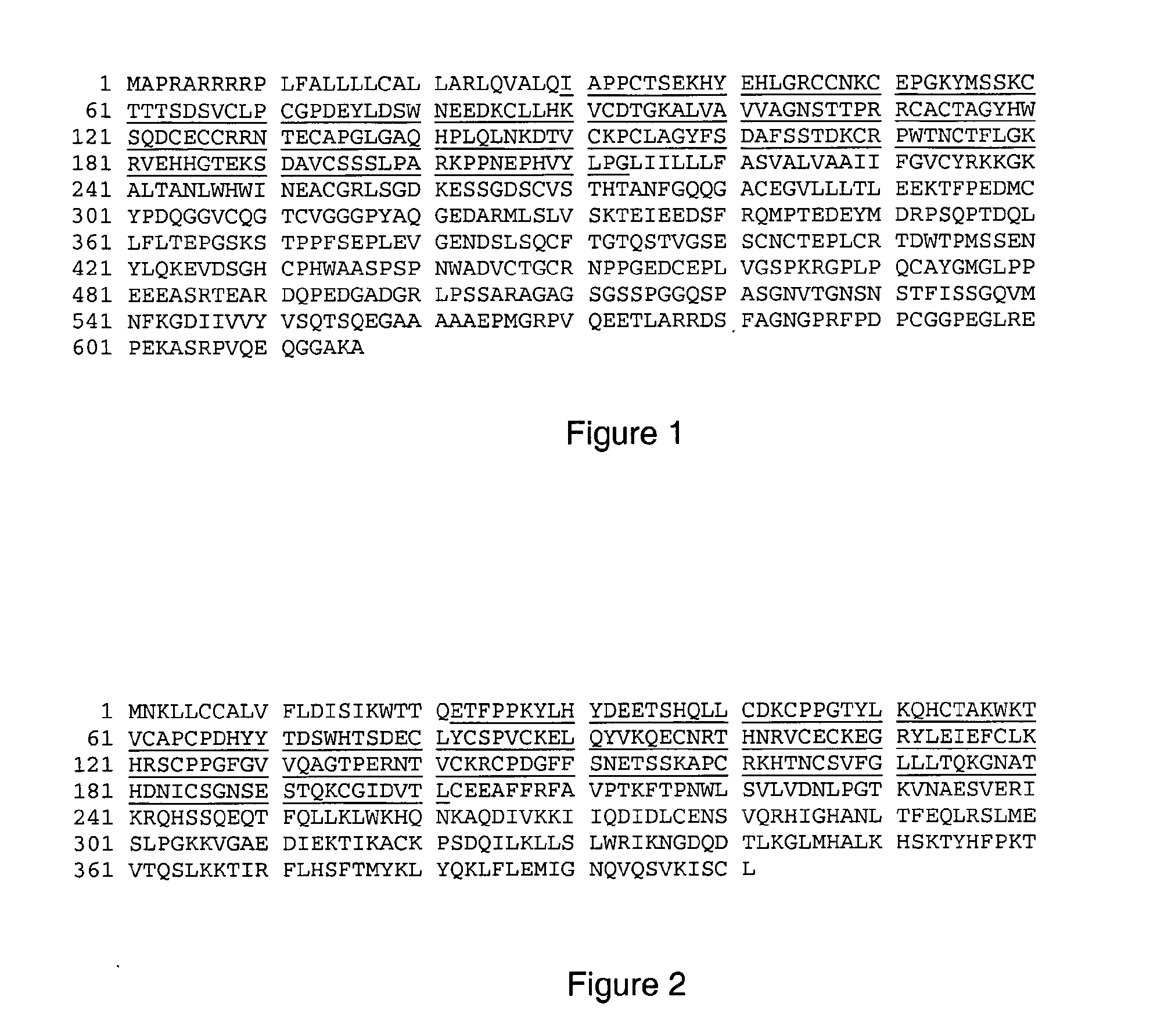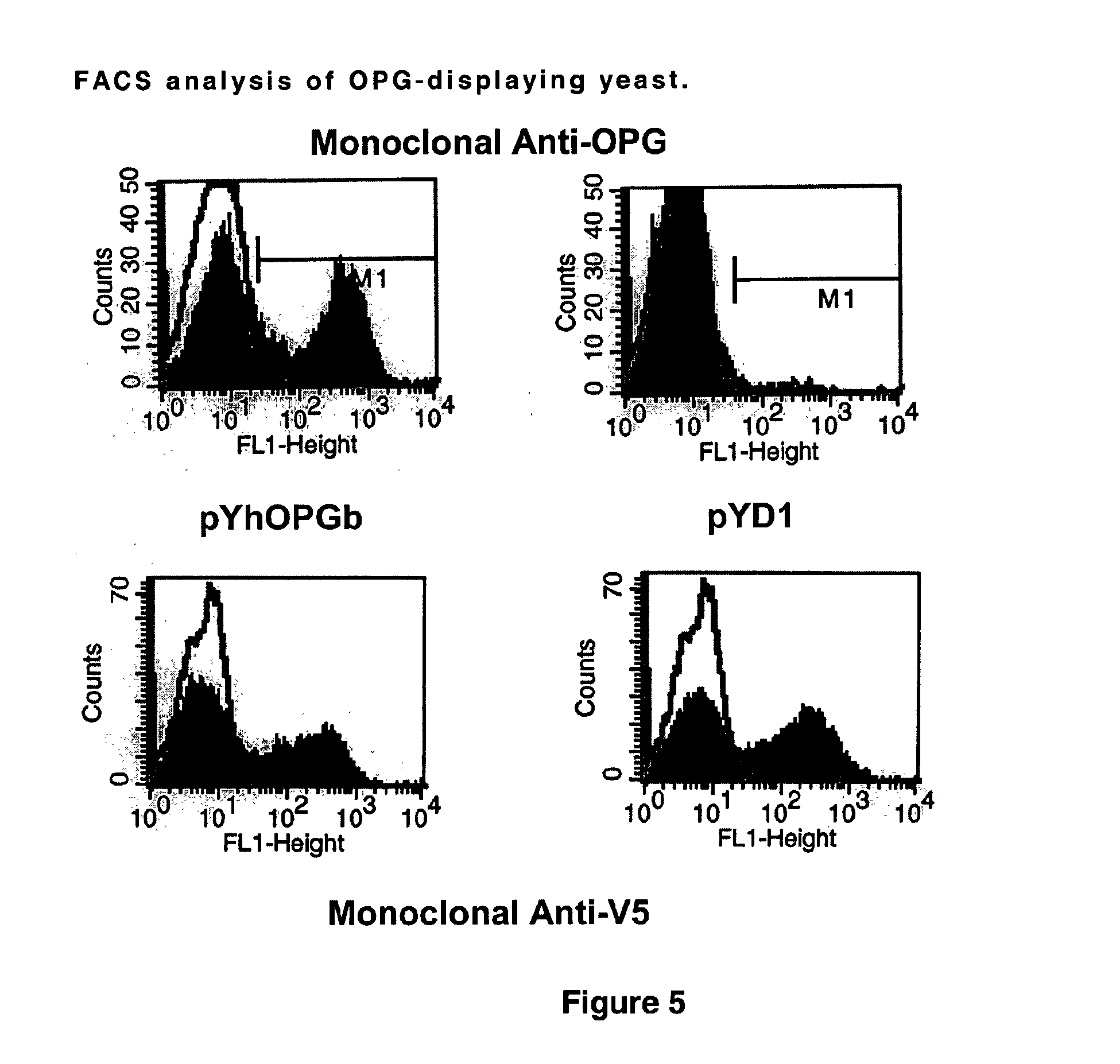Rank ligand-binding polypeptides
a polypeptide and ligand-binding technology, applied in the field of polypeptides, can solve the problems of increasing the risk of fracture, no effective, commercially available treatment, and prone to fracture, and achieve the effects of increasing the functional in vivo half-life and/or serum half-life, and increasing the binding affinity
- Summary
- Abstract
- Description
- Claims
- Application Information
AI Technical Summary
Benefits of technology
Problems solved by technology
Method used
Image
Examples
example 1
Receptor-Ligand Interaction Analysis
Death Receptor 5
[0311]The receptor and ligand parts of the 1D4V structure were used for this example. The structure is used to assess the receptor-ligand interactions in this complex by measuring the distances between atoms of the two molecules. In addition, the receptor part of the structure is used to calculate surface accessibility of individual side chains in the molecule. In this analysis, the ligand molecules are removed before calculation.
Surface Exposure:
[0312]Performing fractional ASA calculations on the extracellular part of Death Receptor 5 of the structure resulted in the determination that the following residues have more than 25% of their side chain exposed to the surface: P69, Q70, Q71, K72, R73, S74, S75, S77, E78, G79, L80, P82, P83, H85, E89, D90, G91, R92, D93, I95, S96, K98, Y99, G100, Q101, D102, T105, H106, W107, D109, L110, L111, F112, L114, R115, T117, R118, D120, S121, G122, V124, E125, L126, P128, T130, T131, T132, R133, ...
example 2
Selection of Mutation Sites
Mutagenesis of the Candidate Molecules
[0334]It should be emphasized that all discussed and prioritized site-directed mutations in the text below originate from observations performed on the ligand binding domain of native human OPG and / or the ligand binding domain of native human RANK. One or more of these suggested site-directed mutations in the native molecules may also be introduced into chimeric molecules produced by shuffling (MolecularBreeding™) of OPG and / or RANK. This is possible due to the fact that such shuffled molecules will comprise parts originating from each of the native molecules (OPG and / or RANK), and because the amino acid sequences of the products of the MolecularBreeding™ reactions will comprise alternating pieces from the native molecules in the same linear order as defined by the above-discussed alignment.
Lysines:
Substitution of Lysines to Remove Attachment Points for PEGylation:
[0335]The effect of PEGylation...
example 3
Example of RANK or OPG Family Shuffling
[0345]RANK or OPG genes are cloned from various primate and mammalian species, e.g. mouse, rat, dog, cat, sheep, goat, cow, horse, rabbit, hamster, guinea pig, humans, chimpanzee, gorilla, orangutan, baboon, mandrill, monkey, bonobo, marmoset, macaque, lemur, gibbon, shrew, siamang, and / or tamarin. The diversity found in the these RANK or OPG genes is used for synthetic family shuffling as described in “Oligonucleotide mediated nucleic acid recombination” by Crameri et al., filed Sep. 28, 1999 (U.S. Ser. No. 09 / 408,392) and “Oligonucleotide mediated nucleic acid recombination” by Crameri et al., filed Jan. 18, 2000 (PCT / USSN 01203) using assembly of oligonucleotides encoding the diversity. After the synthetic family shuffling, the resulting PCR fragment is isolated and digested with KpnI and XhoI and ligated into the same restriction enzyme sites of the pYHRANKb or pYhRANKbE yeast display expression vectors (Sequence 1, 2). The ligat...
PUM
| Property | Measurement | Unit |
|---|---|---|
| molecular weight | aaaaa | aaaaa |
| molecular weight | aaaaa | aaaaa |
| molecular weight | aaaaa | aaaaa |
Abstract
Description
Claims
Application Information
 Login to View More
Login to View More - R&D
- Intellectual Property
- Life Sciences
- Materials
- Tech Scout
- Unparalleled Data Quality
- Higher Quality Content
- 60% Fewer Hallucinations
Browse by: Latest US Patents, China's latest patents, Technical Efficacy Thesaurus, Application Domain, Technology Topic, Popular Technical Reports.
© 2025 PatSnap. All rights reserved.Legal|Privacy policy|Modern Slavery Act Transparency Statement|Sitemap|About US| Contact US: help@patsnap.com



